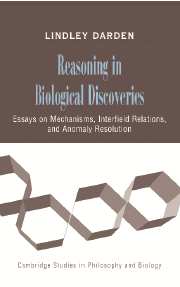 Reasoning in Biological Discoveries
Reasoning in Biological Discoveries Book contents
- Frontmatter
- Contents
- Long Contents
- List of Figures
- List of Tables
- Acknowledgments
- Introduction
- PART I BIOLOGICAL MECHANISMS
- 1 Thinking About Mechanisms with Peter Machamer and Carl F. Craver
- 2 Discovering Mechanisms in Neurobiology: The Case of Spatial Memory with Carl F. Craver
- 3 Strategies in the Interfield Discovery of the Mechanism of Protein Synthesis with Carl F. Craver
- 4 Relations Among Fields: Mendelian, Cytological, and Molecular Mechanisms
- PART II REASONING STRATEGIES: RELATING FIELDS, RESOLVING ANOMALIES
- PART III DISCOVERING MECHANISMS: CONSTRUCTION, EVALUATION, REVISION
- Bibliography
- Index
- References
3 - Strategies in the Interfield Discovery of the Mechanism of Protein Synthesis with Carl F. Craver
Published online by Cambridge University Press: 31 August 2009
- Frontmatter
- Contents
- Long Contents
- List of Figures
- List of Tables
- Acknowledgments
- Introduction
- PART I BIOLOGICAL MECHANISMS
- 1 Thinking About Mechanisms with Peter Machamer and Carl F. Craver
- 2 Discovering Mechanisms in Neurobiology: The Case of Spatial Memory with Carl F. Craver
- 3 Strategies in the Interfield Discovery of the Mechanism of Protein Synthesis with Carl F. Craver
- 4 Relations Among Fields: Mendelian, Cytological, and Molecular Mechanisms
- PART II REASONING STRATEGIES: RELATING FIELDS, RESOLVING ANOMALIES
- PART III DISCOVERING MECHANISMS: CONSTRUCTION, EVALUATION, REVISION
- Bibliography
- Index
- References
Summary
INTRODUCTION
Crucial pieces of the mechanism of protein synthesis were discovered by biochemists and molecular biologists in the 1950s and 1960s. At the outset, the approaches of these fields were very different, focusing on different components and finding different aspects of the mechanism from different ends. By about 1965, the results from the different approaches were integrated. The scientific work leading to this integration reveals general strategies for discovering mechanisms.
This instance of interfield integration, like many other discovery episodes in the biological sciences, crucially involves discovering a mechanism. Focusing centrally on mechanisms provides new ways of thinking about discovery, interfield integration, and reasoning strategies for scientific change. Philosophers of science have separately analyzed scientific discovery, interfield relations, mechanisms, and reasoning strategies. This chapter brings together these disparate topics. A unified approach yields reasoning strategies in discovering mechanisms that integrate results from different fields.
Many philosophers of science (e.g., Popper 1965) have been skeptical about finding methods for reasoning in discovery. Even those who have had much to say about scientific change (e.g., Kuhn 1962; Laudan 1977; Kitcher 1993) have not even discussed reasoning strategies for discovering new paradigms, traditions, or practices. Nonetheless, a few philosophers have worked on discovery (e.g., Nickles, ed. 1980a, 1980b; Meheus and Nickles, eds., 1999). Reasoning in discovery is a more tractable problem if discovery is viewed as an extended process of construction, evaluation, and revision (Darden 1991).
- Type
- Chapter
- Information
- Reasoning in Biological DiscoveriesEssays on Mechanisms, Interfield Relations, and Anomaly Resolution, pp. 65 - 97Publisher: Cambridge University PressPrint publication year: 2006


